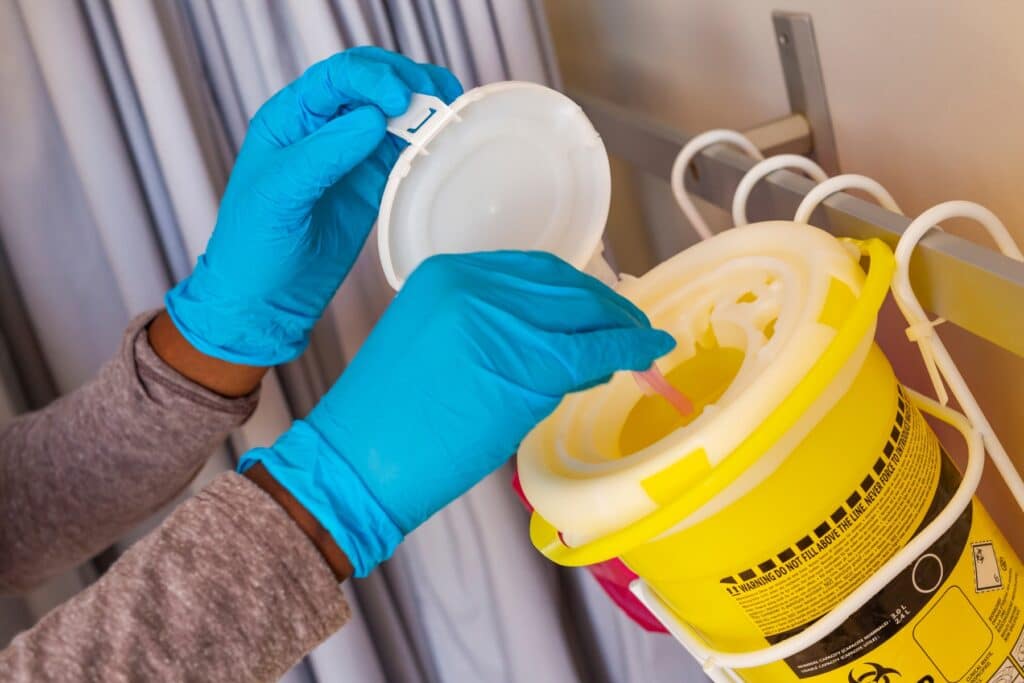The Risks of Improper Sharps Waste Disposal: Protecting Healthcare Workers and the Communit

Proper sharps disposal is crucial in healthcare settings to ensure the safety of healthcare workers and the general public. Improper sharps disposal can lead to needlestick injuries, transmission of infectious diseases, and environmental contamination. This blog post will raise awareness about the risks associated with improper sharps disposal and guide safe handling, containment, and disposal of sharps waste to mitigate these risks and promote a safer healthcare environment.
The Dangers of Improper Sharps Disposal:
Improper disposal of sharps, such as needles, syringes, and lancets, poses significant risks to healthcare workers, waste management personnel, and the community. Needlestick injuries can result in transmitting bloodborne pathogens, including hepatitis B, hepatitis C, and HIV. In addition, these injuries affect the individuals involved and can have long-term consequences for their health and well-being.
Safe Handling and Containment of Sharps:
To minimize the risks associated with sharps disposal, following proper handling and containment procedures are essential. Healthcare workers should receive training on safe handling techniques, including using puncture-resistant containers and avoiding hand recapping of needles. In addition, Sharps containers should be easily accessible, properly labeled, and strategically placed to encourage use.
Disposal Methods for Sharps Waste:
There are specific guidelines and regulations for the disposal of sharps waste. Healthcare facilities should have a comprehensive sharps waste management plan, including proper segregation, containment, and disposal methods. They should collect sharps waste in puncture-resistant containers, and when complete, they should seal, label, and dispose of it according to local regulations.
Promoting Awareness and Education:
Raising awareness among healthcare workers and the general public about the risks of improper sharps disposal is crucial. Therefore, they should implement ongoing education and training programs to ensure that healthcare professionals understand the importance of proper sharps disposal and follow the recommended practices. In addition, public awareness campaigns can help educate patients and the community about safe disposal methods for sharps used at home.
Collaboration with Waste Management Providers:
Healthcare facilities should collaborate with licensed medical waste management providers to ensure proper disposal of sharps waste. These providers have the expertise and resources to safely handle and dispose of sharps waste and comply with regulations. In addition, regular communication and adherence to waste management guidelines are essential to minimize risks and maintain a safe healthcare environment.
Conclusion:
Proper sharps disposal is a critical aspect of healthcare waste management. By understanding the risks associated with improper sharps disposal and implementing safe handling and disposal practices, healthcare facilities can protect healthcare workers, waste management personnel, and the community from needlestick injuries and the transmission of infectious diseases. Together, we can create a safer and healthier environment for all.
References:
https://www.cdc.gov/injectionsafety/providers/provider_faqs.html
https://www.fda.gov/medical-devices/needlestick-injuries/sharps-disposal-containers-what-you-need-know
https://www.who.int/injection_safety/toolbox/en/AM_InjectionSafety_3_SafeWasteManagement.pdf
https://www.osha.gov/SLTC/sharpsinjuries/index.html


